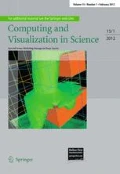Abstract
In order to enable exascale computing, concepts for substantial energy savings are required. Dynamic voltage and frequency scaling (DVFS) is widely known to provide suitable energy saving potentials. However, the customarily utilized DVFS mechanism of the Linux kernel determines clock frequencies solely based on an idle time analysis. In contrast to this, we use an empirical approach based on preparatory measurements of the energy consumption at all available frequencies. From the resulting data we deduce energy-optimal frequencies, which are used in subsequent production runs. The described methodology can be deployed with routine granularity to account for varying code characteristics. For evaluation purposes, the approach is applied to the UG4 numerical simulation software. First results exhibit an average energy saving potential of approximately 10 % while increasing the runtime by about 19 %.


Similar content being viewed by others
Notes
We use the commonly utilized term “energy consumption” despite the fact that electrical energy is converted to thermal energy.
References
Abedi, A: Shiny Profiler - A State of the Art C/C++/Lua Profiler, (2007)
Arteaga, A., Ruprecht, D., Krause, R.: A stencil-based implementation of Parareal in the C++ domain specific embedded language STELLA. Appl. Math. Comput. 267, 727–741 (2015)
Braess, D.: Finite Elements: Theory, Fast Solvers, and Applications in Solid Mechanics. Cambridge University Press, England (2001)
Brodowski, D:. Manpage of cpufreq-set, (2005)
Intel\(^{\textregistered }\) M Processor. White Paper, March (2004)
Emmett, M., Minion, M.L.: Toward an efficient parallel in time method for partial differential equations. Commun. Appl. Math. Comput. Sci. 7(1), 105–132 (2012)
Freeh, V.W., Lowenthal, D.K.: Using Multiple Energy Gears in MPI Programs on a Power-Scalable Cluster. In: Proceedings of the Tenth ACM SIGPLAN Symposium on Principles and Practice of Parallel Programming, PPoPP ’05, pp. 164–173, New York, NY, USA, ACM (2005)
Ge, R., Feng, X., Cameron, K.W.: Performance-constrained distributed DVS scheduling for scientific applications on power-aware clusters. In: Proceedings of the 2005 ACM/IEEE Conference on Supercomputing, IEEE Computer Society, SC 2005, 34 pp, Washington, DC, USA, (2005)
Grasedyck, L., Kriemann, R., Löbbert, C., Nägel, A., Wittum, G.,Xylouris, K.: Parallel tensor sampling in the hierarchical Tucker format. Comput. Vis. Sci. (2015). doi:10.1007/s00791-015-0247-x
Hackbusch, W.: Multi-Grid Methods and Applications, vol. 4. Springer, Berlin (1985)
Hackbusch, W.: Iterative Solution of Large Sparse Systems of Equations. Springer, New York (1994)
Heppner, I., Lampe, M., Nägel, A., Reiter, S., Rupp, M., Vogel, A., Wittum, G.: Software Framework ug4: Parallel Multigrid on the Hermit Supercomputer. In: Nagel, W.E., Kröner, D.H., Resch, M.M. (eds.) High Performance Computing in Science and Engineering ’12, pp. 105–132. Springer, Berlin (2013)
Hotta, Y., Sato, M., Kimura, H., Matsuoka, S., Boku, T., Takahashi, D.: Profile-based Optimization of Power Performance by using Dynamic Voltage Scaling on a PC cluster. In: Proceedings of the 20th International Conference on Parallel and Distributed Processing, IPDPS’06, IEEE Computer Society Washington, DC, USA, (2006)
Hsu, C.H., Feng, W.C.: A Power-Aware Run-Time System for High-Performance Computing. In: Proceedings of the 2005 ACM/IEEE Conference on Supercomputing, SC ’05, IEEE Computer Society, Washington, DC, USA, (2005)
Khabi, D., Küster, U.: Power Consumption of Kernel Operations. In: Resch, M.M., Bez, W., Focht, E., Kobayashi, H., Kovalenko, Y. (eds.) Sustained Simulation Performance. Springer, Heidelberg (2013)
Kreienbuehl, A., Nägel, A., Ruprecht, D., Speck, R., Wittum, G., Krause, R.: Numerical simulation of skin transport using Parareal. Comput. Vis. Sci. (2015). doi:10.1007/s00791-015-0246-y
Lions, J.-L., Maday, Y., Turinici, G.: Résolution d’EDP par un schéma en temps « pararéel ». Comptes Rendus de l’Académie des Sciences - Series I - Mathematics 332(7), 661–668 (2001)
Mazouz, A., Laurent, A., Pradelle, B., Jalby, W.: Evaluation of CPU frequency transition latency. Comput. Sci. Res. Dev. 29(3–4), 187–195 (2014)
Nägel, A., Schulz, V., Siebenborn, M, Wittum G.: Scalable shape optimization methods for structured inverse modeling in 3D diffusive processes. Comput. Vis. Sci, (2015). doi:10.1007/s00791-015-0248-9
Pallipadi, V., Starikovskiy, A.: The Ondemand Governor: Past, Present and Future. Proc. Linux Symp. 2, 223–238 (2006)
Reiter, S., Vogel, A., Heppner, I., Rupp, M., Wittum, G.: A massively parallel geometric multigrid solver on hierarchically distributed grids. Comput. Vis. Sci. 16(4), 151–164 (2013)
Treibig, J., Hager, G., Wellein, G.: LIKWID: A Lightweight Performance-Oriented Tool Suite for x86 Multicore Environments. In: Proceedings of the 2010 39th International Conference on Parallel Processing Workshops, ICPPW ’10, IEEE Computer Society, pp. 207–216, Washington, DC, USA, (2010)
Vogel, A., Reiter, S., Rupp, M., Nägel, A., Wittum, G.: UG 4: A novel flexible software system for simulating PDE based models on high performance computers. Comput. Vis. Sci. 16(4), 165–179 (2013)
Acknowledgments
This work has been funded via the ExaSolvers project by the German Research Foundation (DFG - GZ RE 1612/6-1) as part of the Priority Programme Software for Exascale Computing (SPPEXA). It has been further supported via the EXCESS project by funding from the European Union Seventh Framework Programme (FP7/2007-2013) under grant agreement no 611183.
Author information
Authors and Affiliations
Corresponding author
Additional information
Communicated by Rolf Krause.
Rights and permissions
About this article
Cite this article
Dick, B., Vogel, A., Khabi, D. et al. Utilization of empirically determined energy-optimal CPU-frequencies in a numerical simulation code. Comput. Visual Sci. 17, 89–97 (2015). https://doi.org/10.1007/s00791-015-0251-1
Received:
Accepted:
Published:
Issue Date:
DOI: https://doi.org/10.1007/s00791-015-0251-1




